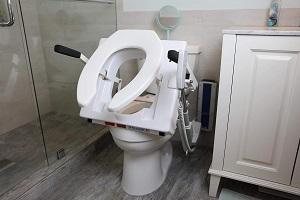The handicap toilet seat market is experiencing significant growth due to increasing awareness and demand for accessible facilities. This market caters to individuals with disabilities, the elderly, and those with mobility issues, ensuring they have the necessary support and comfort when using the restroom. With an aging population and a growing emphasis on inclusive design, the demand for handicap toilet seats is expected to continue rising.
Market Overview
Handicap toilet seats, also known as raised toilet seats or elevated toilet seats, are designed to provide additional height and support, making it easier for individuals with mobility challenges to use the toilet. These seats come in various forms, including those with armrests, padded seats, and adjustable heights, catering to a wide range of needs. The market is segmented based on product type, end-user, distribution channel, and region.
Product Types:
Raised Toilet Seats: These are simple attachments that elevate the height of the existing toilet seat, making it easier for users to sit down and stand up.
Toilet Seat Risers with Arms: These come with armrests for added support and stability, particularly beneficial for individuals with limited upper body strength.
Padded Toilet Seats: These offer extra comfort with cushioning, ideal for those with conditions that cause discomfort when sitting on hard surfaces.
Adjustable Height Toilet Seats: These allow users to customize the seat height according to their specific needs, providing optimal comfort and accessibility.
End-Users:
Residential: Home installations are becoming increasingly common as families seek to make their living spaces more accessible for elderly relatives or family members with disabilities.
Commercial: Public restrooms in malls, airports, hospitals, and other commercial spaces are incorporating handicap toilet seats to comply with accessibility regulations and provide inclusive facilities.
Distribution Channels:
Retail Stores: Home improvement stores, pharmacies, and medical supply stores stock various models of handicap toilet seats.
Online Retailers: E-commerce platforms offer a wide range of options, often with detailed reviews and user feedback, helping consumers make informed decisions.
Direct Sales: Manufacturers and specialized distributors provide direct sales channels, often offering customization and installation services.
Market Drivers
Several factors are driving the growth of the handicap toilet seat market:
Aging Population: With the global increase in the elderly population, the demand for accessible bathroom facilities is rising. Older adults often experience mobility issues and require additional support when using the toilet.
Increased Awareness: Growing awareness about the importance of accessibility and inclusivity is leading to more installations of handicap toilet seats in both residential and commercial spaces.
Regulatory Compliance: Governments and regulatory bodies are enforcing stricter guidelines for accessibility in public spaces, compelling businesses to install handicap-friendly facilities.
Technological Advancements: Innovations in design and materials are resulting in more comfortable, durable, and user-friendly toilet seats, further boosting market demand.
Regional Insights
The handicap toilet seat market is witnessing growth across various regions, with notable differences in demand and adoption:
North America: This region leads the market due to high awareness, regulatory standards, and a significant elderly population. The U.S. and Canada are key contributors to market growth.
Europe: Europe follows closely, with countries like Germany, the UK, and France emphasizing accessible facilities in public and private spaces.
Asia-Pacific: This region is experiencing rapid growth due to increasing healthcare infrastructure, rising awareness, and a growing aging population, particularly in countries like Japan, China, and India.
Rest of the World: Other regions, including Latin America and the Middle East, are gradually adopting accessible solutions as awareness and regulatory frameworks improve.


